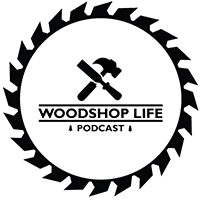This Episodes Questions
Brians Questions
I was at a big box store the other day getting a new toilet. As I passed the lumber section, I saw what looked, from far away, like a piece of walnut. On closer inspection, it was a piece of rainbow poplar in with the ugly, green big box poplar for the same price as the regular poplar. Of course I bought it. My question is: was that awesome and, if so, how awesome?
Thanks, Sincerely, American Bob
Hey Gents! Canadian listener here, I found your podcast about a week ago and i have been listening every day now. Thanks for the content.
I started woodworking this year and just built a new workbench using Paul Sellers plans. It has a laminated 2×3 top with a well so it’s quite heavy. I use both power tools and hand tools. The main point of making this new bench was to make it heavy so it doesn’t slide during hand planing, but it still slides!!! Any tips on how to prevent workbench slide?
My workbench needs to float away from the wall so i am looking for a solution that isn’t “put something behind it”.
Any tips would be greatly appreciated!
Thanks again! Tyler
Guys Questions
I have a question regarding the drum sander. I only swear while doing two things, playing golf and using my drum sander. I bought a new Supermax 16-32 and had nothing but problems with it and had to send it in for warranty repair. I sold it and upgraded to a Powermatic PM2244 which I believe Guy has. I definitely have had better luck with the Powermatic but still have issues with burning at times. I do make end grain cutting boards for friends, family and donations. I know the end grain is extremely hard. I take very shallow passes, usually .002 to .004 per pass running the conveyor at 4 FPM and no matter how careful I am I still will get burning and grooves. It doesn’t matter the grit of the sandpaper. I’ve experimented with feed rate with no luck. I know the glue does create heat and builds up on the paper so I clean the sandpaper often. Do you have any recommendations or should I start a swear jar to raise money for charity? Thanks again, Matt
Good evening, gentleman! Thanks for this amazing podcast and all the info! I had a quick question on blades for a cheap table saw.
I used to use the newer delta contractors saw (miss it so much..best saw I’ve used) unfortunately, had to down size. So I’m back to my ryobi cheaper saw. I keep the blade and adjustments true, so it cuts well….for what it is. Yall mentioned a few weeks back, thin curf blades vs regular 10″.
Question: I use a smaller circular saw blade in my table saw. Have you? Have you noticed more power and better cuts? Because I have. In all saws I’ve used. Would you recommend using a smaller blade in a cheap table saw to get more power to the blade? I’m just kinda wondering your thoughts on that. I’m a one man backyard shop that mostly is building cabinet doors out of poplar and barn doors out of pine, and poplar. Thoughts? Thanks in advance! Keep up the amazing programming! Crafted Carpentry Canada
Huy’s Questions
EH gentlemen from the Niagara region in Ontario Canada, been listening to your excellent podcast for some time now and thoroughly enjoy it so thank you for that. My question concerns urns and specifically how it seals.
For context, my wife’s grandmother has recently passed away and I was asked by my wife’s family to make her urn.
I don’t own a lathe but I very carefully using an angle grinder with a shaping disc, orbital sander and an excessive amount of hand sanding created a typical tapering cylindrical urn that is fatter about 1/3 of the way down from the top, tapering upwards and downwards from there and I used segmented layers to achieve this.
The urn is made of blood wood and has soft maple accent rings.
The lid I created was a simple circle that I used dowel pins and magnets to secure it to the top of the urn.
I am extremely happy with how the urn turned out and how the lid looks on the urn but I am not 100% happy with how the lid I attached and sealed.
So after all that my question is: how would you guys go about creating and attaching the lid? In my research I did see most urns have a threaded component on the bottom of the urn and that’s how they seal.
Apologies for the long winded question, any insight would be greatly appreciated. Thanks James
I have a question about types of glue for veneering projects. In the past I’ve used Unibond 800 with good results. The problem I have is the very short shelf life for someone who does 1 or 2 veneering projects per year. Are you aware of any other solutions with longer shelf life without resorting to some PVA glue?
Thanks and keep up the good work! Jeffrey
